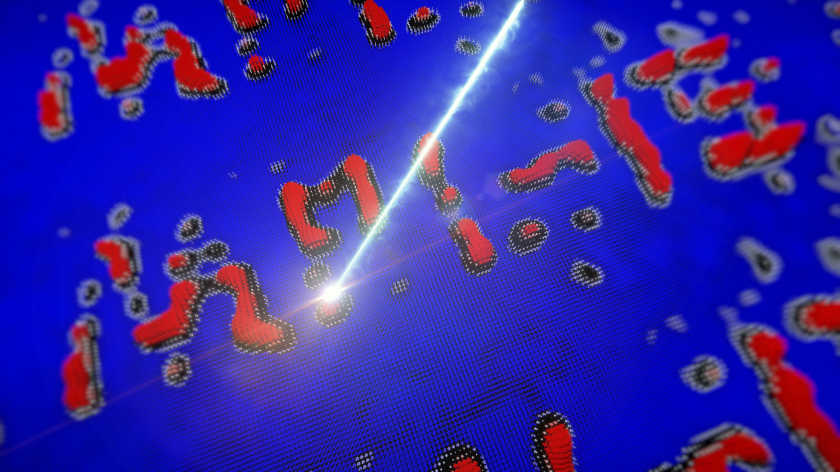New interaction between light and matter discovered at BESSY II

A bundled soft X-ray beam with a diameter of less than 50 nanometers writes numerous magnetic vortices, which together form the term "MPI-IS". © Alejandro Posada, Felix Groß/MPI-IS
A German-Chinese team led by Gisela Schütz from the MPI for Intelligent Systems has discovered a new interaction between light and matter at BESSY II. They succeeded in creating nanometer-fine magnetic vortices in a magnetic layer. These are so-called skyrmions, and candidates for future information technologies.
Skyrmions are 100 nanometre small three-dimensional structures that occur in magnetic materials. They resemble small coils: atomic elementary magnets - so-called spins - which are arranged in closed vortex structures. Skyrmions are topologically protected, i.e. their shape is unchangeable, and are therefore considered energy-efficient data storage devices.
Soft x-rays at BESSY II
In a series of experiments on the MAXYMUS beamline of BESSY II, the researchers have now shown that a bundled soft X-ray beam with a diameter of less than 50 nanometres can generate a magnetic vortex of 100 nanometres. In order to make the skyrmions visible, the researchers use the MAXYMUS scanning transmission X-ray microscope. This is a high-resolution X-ray microscope, weighing 1.8 tons, located at BESSY II.
Serendipitous discovery
This discovery was made by chance, as this type of interaction between light and matter was previously completely unknown. "We don't know how light writes matter," says Dr. Joachim Gräfe, head of the research group Nanomagnonics and Magnetization Dynamics at MPI-IS. He is one of the main authors of the study, which was published in Nature communications in February. "We can describe certain properties phenomenologically. We know that it has to do with the X-ray beam. It's not just an energy input like heat that writes the Skyrmion. It's really a resonant effect: we can directly excite the atoms responsible for magnetism." This enabled him and his team to write "MPI-IS" (see figure).
Outlook: Future Spintronics
The results are particularly relevant for the development and production of so-called spintronic data carriers, which store information in skyrmions. They are considered to be energy-efficient and less susceptible to interference. However, this development can only take its course if skyrmions can be created precisely and with a perfect fit - and this has now become possible for the first time. "Our goal is for X-rays to serve as a tool for determining or writing the arrangement of magnetic structures in the future."
red/MPI-IS
https://www.helmholtz-berlin.de/pubbin/news_seite?nid=21272;sprache=en
- Copy link
-
Peat as a sustainable precursor for fuel cell catalyst materials
Iron-nitrogen-carbon catalysts have the potential to replace the more expensive platinum catalysts currently used in fuel cells. This is shown by a study conducted by researchers from the Helmholtz-Zentrum Berlin (HZB), Physikalisch-Technische Bundesanstalt (PTB) and universities in Tartu and Tallinn, Estonia. At BESSY II, the team observed the formation of complex microstructures within various samples. They then analysed which structural parameters were particularly important for fostering the preferred electrochemical reactions. The raw material for such catalysts is well decomposed peat.
-
Helmholtz Investigator Group on magnons
Dr Hebatalla Elnaggar is setting up a new Helmholtz Investigator Group at HZB. At BESSY II, the materials scientist will investigate so-called magnons in magnetic perovskite thin films. The aim is to lay the foundations for future terahertz magnon technology: magnonic devices operating in the terahertz range could process data using a fraction of the energy required by the most advanced semiconductor devices, and at speeds up to a thousand times faster.
-
The future of corals – what X-rays can tell us
This summer, it was all over the media. Driven by the climate crisis, the oceans have now also passed a critical point, the absorption of CO
2 is making the oceans increasingly acidic. The shells of certain sea snails are already showing the first signs of damage. But also the skeleton structures of coral reefs are deteriorating in more acidic conditions. This is especially concerning given that corals are already suffering from marine heatwaves and pollution, which are leading to bleaching and finally to the death of entire reefs worldwide. But how exactly does ocean acidification affect reef structures?
Prof. Dr. Tali Mass, a marine biologist from the University of Haifa, Israel, is an expert on stony corals. Together with Prof. Dr. Paul Zaslansky, X-ray imaging expert from Charité Berlin, she investigated at BESSY II the skeleton formation in baby corals, raised under different pH conditions. Antonia Rötger spoke online with the two experts about the results of their recent study and the future of coral reefs.
